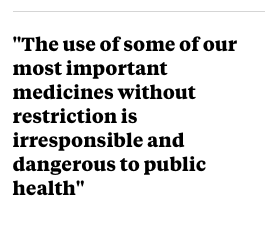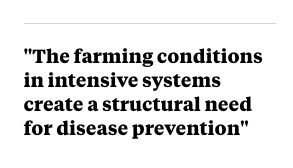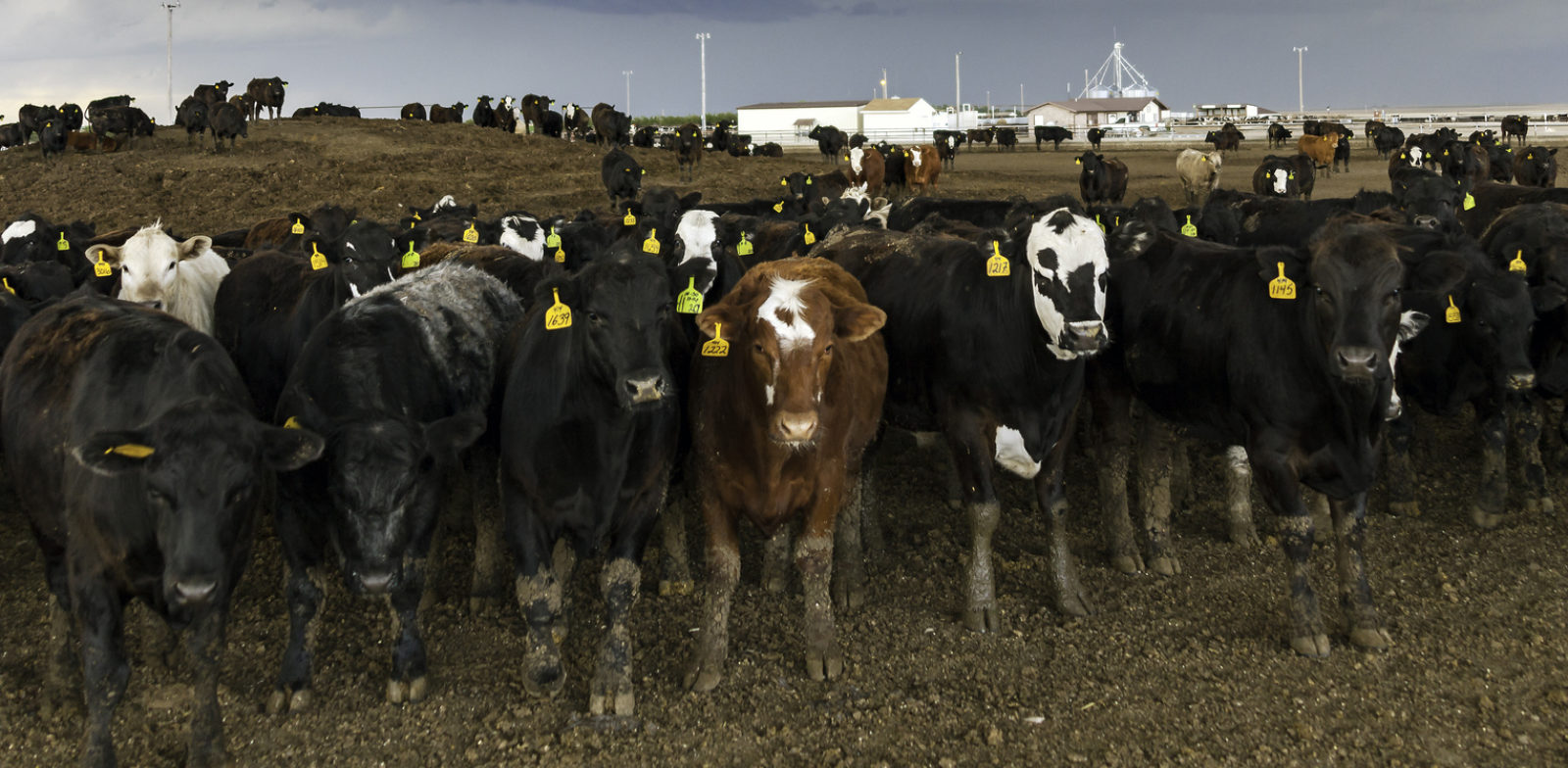The Bureau of Investigative Journalism: Antibiotics in agriculture: The blurred line between growth promotion and disease prevention
by Ben Stockton , Natalie Jones | September 19 2018
In an investigation published today, the Bureau revealed how US farm animals are still being dosed with antibiotics vital to human health, despite efforts to curtail such usage and combat the spread of deadly superbugs. We also found that a regulatory loophole means that using antibiotics to make animals fatter – a process known as growth promotion – is technically still possible, despite this practice being banned in January 2017. Here, we explain how, using the example of one particular drug: Tylosin.
The term “growth promotion” refers to the practice of giving animals tiny doses of antibiotics over a long period of time in order to make them fatter, quicker. The discovery that such drugs optimise conditions within an animal’s body for efficient growth was made by chance by researchers in the 1940s and has been exploited ever since. As industrialised farming grew, using antibiotics as growth promoters became standard practice.
Dosing animals continuously with antibiotics is also used in large-scale farming to prevent the diseases that can frequently occur in such settings. The problem is that when bacteria come into frequent contact with small amounts of antibiotics, they evolve to develop resistance to the drugs. The widespread use of antibiotics in agriculture has been a significant driver of the world’s superbugs crisis, and many countries have taken action to reduce the use of these critical drugs in farming.
The US Food and Drug Administration (FDA) introduced new rules in January 2017 requiring farmers to get prescriptions for all antibiotics, and banning the use of such drugs to fatten animals. The ban resulted in more than 80 products marketed as growth promoters being taken off sale. But 31 remained on the market, with the words “growth promotion” removed from their labels. They were able to remain on sale because the drugs can still be used to treat and prevent diseases.
There is no clear line between growth promotion and disease prevention – in fact it is precisely because they prevent certain diseases that some antibiotics are able to stimulate growth. Experts say that means those particular antibiotics need restrictions on how long they can be administered for – something which the 2017 regulations did not cover.
The Bureau’s investigation into the use of antibiotics on US farms found that the majority of the 31 drugs still on sale are used to prevent just a small handful of diseases, and they have no limits on how long they can be used for.
One such antibiotic is tylosin. So why can farmers continue to legally give daily doses of tylosin – an antibiotic targeted by the FDA ban – to their animals?
A “critically important” drug
Tylosin is used to prevent liver abscesses in cattle. Up to a third of cows on feedlots – where beef cattle are fattened for up to six months before slaughter – can suffer from liver abscesses, one of the biggest disease burdens that farmers face.
If the disease is allowed to develop, it stunts the growth of the cow, affecting its value after it is slaughtered. The carcass of a cow with liver abscesses is estimated to be worth about $50 less on average than a healthy one. Diseased livers also can’t be sold, further affecting profits. On vast feedlots, some of which hold up to 100,000 cows at a time, liver abscesses can be costly.
The antibiotic tylosin is the most effective drug to keep the disease at bay. However it is also one of a group of antibiotics (the macrolide class) which the World Health Organisation has classified as being among the highest priority “critically important” drugs to human health. Health agencies have warned that macrolides should only be used “prudently” because of their importance to human and animal health and the risk of contributing towards resistant infections. Studies have found that using tylosin fuels resistance to erythromycin, an antibiotic commonly used to treat people with chest infections, ear infections and sexually transmitted infections.
Using tylosin as a growth promoter was banned by the European Union in 1999, with restrictions preventing its longterm use. But under FDA rules, it can still be administered in the US for months on end.
Experts question whether the FDA regulations have been effective if it’s still possible for farmers to use an antibiotic targeted by the ban, such as tylosin, for long periods of time. Some say it gives producers a loophole which allows them to continue using antibiotics in the same way as they did before, without calling it growth promotion.
 Shelby Luce, an associate at the US Public Interest Research Group said: “The federal government has not taken appropriate action to stem this problem and the use of some of our most important medicines without restriction is irresponsible and dangerous to public health. These guidelines, essentially, just change the label without provoking meaningful behaviour change.”
Shelby Luce, an associate at the US Public Interest Research Group said: “The federal government has not taken appropriate action to stem this problem and the use of some of our most important medicines without restriction is irresponsible and dangerous to public health. These guidelines, essentially, just change the label without provoking meaningful behaviour change.”
But Tiffany Lee, a vet and the director of regulatory and scientific affairs at the North American Meat Institute, an agricultural trade association, believes the need for farmers to get a prescription for any antibiotics stops this from happening. “Veterinarians know the difference between growth promotion and antibiotics for disease prevention, and they understand that they are prescribing these antibiotics for disease prevention,” she said.
Why do cows get liver abscesses?
Studies suggest liver abscesses are caused by the high-energy grain fed to cows to help fatten them up before slaughter. The grain ferments quickly, creating acid that damages the walls of one of the stomachs. Bacteria can then spread in the bloodstream to the liver, where it forms lesions.
Critics say that even if there is no foul play and tylosin is genuinely being used to prevent liver abscesses and not for growth promotion, this still constitutes unnecessary use as a healthier diet wouldn’t require supplementary antibiotics.
But while cows reared on traditional grass diets are less likely to suffer from liver abscesses, this slower, more resource-demanding feed is not “economical” for the industry, said Professor T.G. Nagaraja from the College of Veterinary Medicine at Kansas State University.
“Roughage is more expensive than grain and it takes a longer time. You have to feed animals for a long period of time to reach the weight for the animal to get slaughtered,” he said.
The pressure to produce meat cheaply and efficiently, and with no alternatives for preventing liver abscesses in cattle on grain-heavy diets, means tylosin use on feedlots remains a necessity, the industry argues.
“The feedlot industry is really looking for a way to not use tylosin,” said Nagaraja, who is leading a team hoping to develop a vaccine within the next couple of years. “But right now they don’t have any choice.”
The grain-heavy diet could be one of the many ways intensive farming creates a greater need for antibiotics. Although antibiotics are needed in all forms of farming to treat sick animals, academic Dr Thomas Van Boeckel says they are prescribed more on intensive farms where disease poses a greater threat. Farms such as feedlots have been criticised for creating conditions in which bacteria can flourish, thereby driving higher antibiotic use, whether that’s due to diet (such is the case for liver abscesses) or because of poor sanitation and overcrowding.
 “The farming conditions in intensive systems create a structural need for disease prevention. The cheapest way to address this need is through use of antibiotics,” said Van Boeckel, a prominent researcher of antibiotic use in agriculture based at the Swiss university, ETH Zurich. “In my opinion this is the core of the problem.”
“The farming conditions in intensive systems create a structural need for disease prevention. The cheapest way to address this need is through use of antibiotics,” said Van Boeckel, a prominent researcher of antibiotic use in agriculture based at the Swiss university, ETH Zurich. “In my opinion this is the core of the problem.”
Animal welfare concerns
The FDA began to formulate plans in late 2016 to bring in measures that would place limits on how long all antibiotics could be used for, with particular focus on tylosin and how it is used to prevent liver abscesses. But the proposed measures attracted widespread condemnation from the agricultural industry.
In a letter to the FDA in March 2017, the National Cattlemen’s Beef Association, the biggest trade body for beef and dairy producers in the US, said: “Liver abscesses pose significant animal welfare and economic concerns to the beef industry in the United States […] Assigning durations of use for control of liver abscesses outside of a science-based approach poses an unnecessary risk to both animal and human health.”
Also commenting on the proposed FDA plans, the American Association of Bovine Practitioners argued that “licensed veterinarians can use their medical expertise to properly and judiciously utilize medically important antibiotics to prevent, treat and control disease in cattle more effectively than a defined duration label would be able to achieve.”
An FDA spokesperson told the Bureau that the continuous use of medically important antibiotics was not “consistent with the FDA’s judicious use principles” and the agency is currently reviewing the public comments collected in 2017 before further plans are announced.
In relation to specific diseases that have no duration limits, such as liver abscesses, the FDA said it is “interested in whether alternative approaches could better manage such conditions. This may include more targeted use of antimicrobials based on labels revised to align with judicious use principles, alternative non-antibiotic therapeutic options, changes in management/production practices, or other interventions.”
The FDA is planning to release data on pharmaceutical sales for animal antibiotics for 2017 in December, which will give an indication of how well its new guidance is working. The department recently announced it would set “reasonable” limits on how long all antibiotics important for human health can be administered for on farms by 2023. But exactly what constitutes “reasonable” remains yet to be defined.
